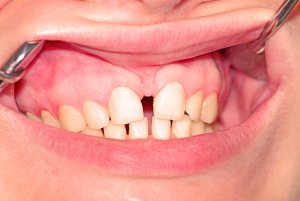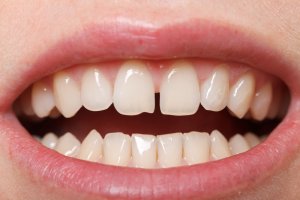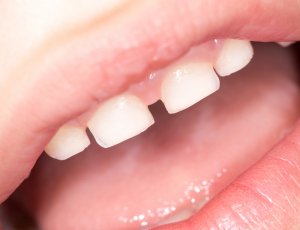A gap between two teeth is known as a diastema. Gappy teeth are really common in children but are generally not something to be worried about since the spaces often disappear as adult teeth erupt.
If you have a diastema or several gaps between your teeth after all of your adult teeth have come through, you may want to explore different treatment options for diastema closure. You can also check treatment options for various types of malocclusion and we’ll go through everything you need to know, and answer the following questions:
- What is diastema?
- What causes diastema?
- How do you get rid of a gap between the teeth?
- How much does it cost to close teeth gaps?
Keep reading to find out how to get rid of gaps in teeth, including various malocclusion treatments, such as dental braces, aligners, and other dental procedures. We hope this helps you decide the best course of action for the gaps between your or your child’s teeth.
If you want to close a diastema but don’t like the idea of fixed metal braces, consider clear aligners instead. Aligners are almost invisible but are very effective at treating teeth spacing.
Read about the best teeth aligners starting from £1,295
What is diastema?
The simple definition of a diastema is a gap between two teeth. It’s most noticeable with a gap between front teeth, but spaces can occur anywhere in the mouth. A gap in the lower teeth is called a mandibular diastema whereas a gap in the front two teeth is called a midline or median diastema.

According to this report in the Journal of the American Dental Association, between 1.6% and 25.4% of people have a diastema.
That’s quite a gap! Although the findings are presented in a fairly technical way, it’s worth scrolling through if you want to see some pictures of diastema closure before and after.
Gaps in baby teeth are pretty normal because at this stage the jaw is still growing and the teeth developing. As children grow up, lose their milk teeth, and get their adult teeth, any spaces often close naturally. If gaps are left then you can seek advice from a dentist.
People with spaces between their teeth need to take extra care with their oral health. A water flosser and interdental brushes can help, making it easier to clean gaps between teeth.
What causes gaps in front teeth?
There are quite a few different diastema causes. The main one is a mismatch in the size of teeth vs jaw size. If your jaw is too big or teeth are too small then they won’t align properly.
A diastema is a term for a space between teeth, often the upper front teeth in particular. For children, a noticeable gap between front teeth isn’t generally harmful and will usually close when their permanent teeth come in.
Teens and adults may choose to have a diastema closed for cosmetic reasons. Treatment options include both orthodontic closure or restorative treatment to widen the teeth, like porcelain veneers.
A diastema between posterior teeth can be a food trap, and aside from being annoying, could lead to bone loss or tooth decay. Some spaces may open as a result of missing posterior teeth putting excess forces on the remaining teeth.
Finally, underlying periodontal disease is a common reason for spaces developing.
Often, however, a diastema is mainly a cosmetic issue and each patient will have to decide whether it’s something they can live with or not.
Dr. Greg Nalchajian, Nalchajian Orthodontics
Gaps in front teeth can also be caused by extra tissue growing above the teeth. The bit of skin between your lip and top front teeth is called your frenum and this can overgrow sometimes. If it does grow too much it can force a diastema between your two upper front teeth.

Other things that cause a diastema are generally based on behaviour, such as:
- Thumb sucking
- Tongue thrusting
- Poor dental hygiene leading to gum disease
Thumb sucking will normally cause a midline diastema because this is where the thumb exerts pressure. Tongue thrusting can cause a mandibular diastema if the tongue is pushing against the lower teeth when swallowing. Both of these habits can be corrected in childhood to prevent long-term issues.
If you suffer from periodontitis (severe gum disease), you could end up losing teeth. The infection can also lead to bone loss in your jaw which can make your teeth move and create gaps.
What is a peg lateral?
Sometimes the tooth called the second incisor – that’s the one next to the very front two teeth – doesn’t develop properly. This is known as a peg lateral, which is generally small and pointy. Because it is smaller than it should be, there might be gaps on either side.
Crowns, teeth implants and veneers (see below) are all options for fixing a peg lateral.
How to get rid of gaps in teeth
There are two approaches to closing gaps in teeth. Small gaps can often be filled using dental composite or veneers. In other cases, it’s better to close the teeth gap with braces or aligners.
Your dentist will be able to talk you through which treatment is best for the gaps in your teeth, since every case is different.
Closing gaps in teeth with braces
Braces can be used to adjust the position of diastema teeth and close gaps in the mouth. Larger gaps usually require treatment with braces, whereas smaller gaps can be closed in other ways – more on these in a moment.
You’ll need to wait until all adult teeth have erupted before braces for a diastema can be considered. This is because a child’s jaw can grow at a different rate to their teeth, and the mix of milk teeth and adult teeth can cause natural spacing between teeth.
Once everything has developed, if any problems still persist then your dentist will discuss different braces options.
In this time lapse video you can watch the progress made by one patient with metal braces to close the gap in his front teeth:
Can aligners treat a diastema?
If you want to close gaps between teeth without metal braces, consider clear aligners, also known as invisible braces. They are very hard to notice, unlike conventional braces, but they are still an effective treatment for most patients with teeth spacing. They also have the added convenience of being removable.

Invisalign is one of the best-known brands of aligner, but also one of the more expensive treatment options. Their advanced technology does make them able to treat up to 90% of cases, so if you have a severe diastema, you may want to consider Invisalign.
There are more affordable brands like NewSmile, which save money by dealing directly with you – no adjustments needed at the dentist. You record your progress by checking in via an app, and your assigned dentist monitors your treatment in this way.
You can read about Invisalign and other alternatives here, and learn more about the pros and cons of at-home aligner treatments. Alternatively, take a look at our recommended brands below and see if one of these would be suitable for you:
- Up to 80% cheaper than Invisalign
- Buy now, pay later in interest-free instalments.
- Rated 4.5/5 on Trustpilot
- Starting at just 625 for single-arch treatment!
Caspersmile offers a convenient at-home solution for teeth straightening with their clear aligners. You can achieve a perfect smile in 3-5 months, wearing the aligners for 22 hours a day.
Caspersmile’s treatment is overseen by UK-licensed dentists, ensuring professional guidance throughout the process. The treatment starts with an at-home impression kit or a visit to a scan center, followed by a 3D preview of your future smile.
Every treatment comes with free teeth whitening, so you can brighten your smile while you straighten it!
- Hybrid in-office and remote treatment
- In-person visits with your orthodontist for safe, effective treatment
- Treats even complex cases of misalignment
- Various pricing options
Discover the flexibility and effectiveness of Impress Invisible Braces, the hybrid orthodontic solution that blends in-person care with the convenience of remote appointments. Suitable for both kids and adults, Impress offers a range of treatment options designed to cater to various needs, from mild to severe cases of misalignment. With the initial consultation happening in person, you’re assured of a tailored treatment plan that can address even the most complex orthodontic issues.
Impress Treatment Plans:
- Impress Super Light ($6,999): Perfect for mild cases, this plan promises results in up to 3 months, making it the quickest route to a better smile.
- Impress ($4,599): Designed for moderate cases, this option aims to perfect your smile within 4-10 months.
- Impress Plus ($5,599): Tailored for moderate cases requiring a bit more time, this plan spans 11-14 months.
- Impress Advanced ($6,999): The go-to choice for complex cases, offering comprehensive treatment over 11-24 months.
- Teens ($4,599): Specifically designed for teenagers, this plan addresses mild cases within 4-10 months, ensuring a confident smile during those crucial years.
- Impress Kids ($4,599): Offering orthodontic treatment for children, this plan covers a period between 8-18 months, setting the foundation for a lifetime of healthy smiles.
With flexible payment plans available, starting your journey to a perfect smile has never been easier or more accessible. Whether you’re looking for a quick fix or need extensive treatment, Impress Invisible Braces provide a tailored solution that meets your needs and budget. Click below to get started!
- Free retainers and whitening
- Nighttime aligners available
- 0% interest finance options
£1,395£1,295 or £83.33/month
NewSmile is a Canadian company that brought its clear aligners to the UK market in 2022. NewSmile aligners are made from the clearest material and the company offers excellent service at the best price.
They don’t have any physical locations, so you’ll need to purchase an aligner kit to get started. One of their Impression Specialists will guide you through the process on a video call when you’re ready.
NewSmile aligners are very affordable, costing just £1,395 (currently discounted to £1,295). But even better, this price includes whitening foam to use in your aligners, plus your first set of retainers!
Choose their daytime package for treatment in 4-6 months, or nighttime aligners for a more discreet treatment that takes 8-10 months. Both options come with 0% interest payment plans available.
How can I get rid of gaps in teeth without braces?
Braces and aligners aren’t the only solutions for filling gaps in teeth. The two other options that may be offered are veneers and composite which are best for closing just one or two gaps. If several of your teeth are over-spaced then braces may be a better option.
Your dentist will discuss which treatment is most suitable for you, but here we’ll go through the pros and cons of each to help you understand your options.
Porcelain veneers
A porcelain veneer is a thin cover that fits on top of your natural teeth to alter the shape and/or colour. Fixing a small diastema with veneers is quite straightforward, but this treatment is only suitable for adults.
When filling gaps between teeth using veneers, the dentist simply makes the veneers slightly wider than the original teeth. When they are fitted, they meet in the middle and hide the gap.

Porcelain veneers usually require two dental visits; one to prepare the teeth and take measurements for the veneers, and another to fit them once they have been made in a lab. You can read more about veneers here.
Veneers can help cover up small gaps in teeth naturally, but the results may not look so good if used for a large gap. You don’t want to look like you have oversized front teeth!
Dentists are good judges of what will look natural; they look at different smiles every day, after all, so you should trust your dentist’s opinion about the best option for you.
Composite bonding
With diastema, a composite material is applied directly to the teeth – no lab work is required. The dentist builds up and shapes the composite to give the desired appearance. In the case of filling gaps in teeth, the composite is used to extend the tooth slightly to close the diastema.
Composite material can be used to cover the original tooth completely, in which case it’s called a composite veneer. It’s also a common treatment for chipped tooth repair.
In the following video, you can see a dentist perform diastema closure with composite resin on the patient’s four front teeth. The material is applied to the sides of the teeth to fill the gaps, before being hardened and shaped.
Veneers vs. composite for a diastema
The table below summarises the two main options for treating a diastema without braces, including teeth gap treatment costs for both:
Porcelain Veneers | Composite Bonding | |
What does it involve? | A porcelain cover is applied to the teeth, made slightly wider than the teeth to fill in a gap | A composite material is added directly to the teeth to build them up, increasing the size of the teeth to fill the gap |
How long does it take? | 2 visits – one consultation and another 1-3 weeks later for fitting | Can be done in one visit |
What does it cost? | £400 - £1000 per tooth | £90 - £300 per tooth |
Pros? | Long lasting and hard wearing | Fast and lower cost |
Cons? | Takes away some healthy tooth, takes two dentist visits, only works for small gaps | Will need touching up – bonding lasts up to 5 years, only works for small gaps and is liable to colour change |
How much does a diastema closure cost?
Closing gaps in teeth costs anywhere from £200 (for composite bonding to fill a gap between two front teeth) to thousands of pounds for porcelain veneers or braces.
We’ve already covered the prices for veneers and bonding in the table above. Treating diastema teeth with braces costs between £1,300 and £5,500, depending on the type of braces used.

Invisalign diastema treatment prices start at around £2,000 for people who need mild orthodontic treatment. More severe cases will cost up to £5,500 to treat. The only way to know the cost for your case is to make an appointment with an Invisalign dentist.
If you opt for remote monitoring with a direct-to-consumer brand, the cost can be as low as £1,295 (with NewSmile).
Filling gaps between teeth is unlikely to be considered a medical necessity, and therefore the NHS usually doesn’t cover diastema closure costs in the UK.
Children and adults with severe cases of teeth spacing, perhaps as a result of hypodontia (naturally missing teeth), may be eligible for braces and then dentures or dental bridges to fill the gaps. The NHS also covers treatment for periodontitis, which may be the cause of gaps between teeth.
For more information about the different kinds of braces, you can read this guide. You may also want to explore your finance options for dental work.
Conclusion
A diastema, or gap in your teeth, is generally not a medical concern in itself, but there can be underlying reasons you have gaps in your front teeth, or between other teeth, so it’s best to see a dentist for a proper assessment.
Don’t be too concerned if your baby has gaps in their teeth; this is quite common and may well fix itself when their adult teeth erupt.
Closing gaps in teeth is reasonably straightforward and traditional braces aren’t always necessary. Clear aligners are a less noticeable way to close gaps in teeth and tidy up any other cosmetic flaws that might be bothering you.
Whichever treatment you decide on, it’s a good idea to visit a dentist for a general checkup before commencing.
FAQs
Can a retainer fix gaps in teeth?
Retainers can be used for some orthodontic treatments, but are limited in what movement they can achieve. Fixed or removable braces are a more effective way to correct the diastema.
How can I fill gaps in teeth naturally?
It really depends on what you mean by ‘naturally’. Although braces, veneers, and bonding may not be considered natural, they are safe and effective and deliver natural-looking results.
How can I fill a gap between teeth at home?
You could use a temporary filling material but this won’t look good or be durable. A home teeth straightening kit is a better solution if you don’t want to visit a dentist.
Are gaps in baby teeth normal?

Gaps are normal in baby teeth because at this age, the jaw is still developing and a child’s baby teeth may end up looking spaced out. This is also true when both baby and adult teeth are present.
I have gaps in my teeth after braces, what can I do?
Braces are designed to correct the position of your teeth and give you a properly aligned smile. If you aren’t happy with the results of your treatment then refer back to the orthodontist who treated you.
Does flossing create gaps in teeth?
There isn’t any reason that normal flossing would cause gaps to appear between your teeth. Flossing incorrectly could harm the gums and cause them to recede, creating the appearance of gaps between teeth.
Do gaps in teeth get bigger with age?
As we get older our teeth can shift position and the enamel may begin to erode. This can cause gaps in teeth to get bigger with age, but it’s possible to get braces for gaps in teeth later in life.
How long do braces take to close a gap?
This really depends on how much tooth movement is needed to remove the gaps between teeth. Treatment with braces for a teeth gap can be as quick as three months.
JADA: Treating a maxillary midline diastema in adult patients. Consulted 22nd April 2023.
ResearchGate: A clinical case report on the treatment of mandibular diastema, associated with tongue interposition and tongue thrust swallow. Consulted 22nd April 2023.
Prices stated are indicative only and are based on publicised treatment prices at dental clinics across the UK.







